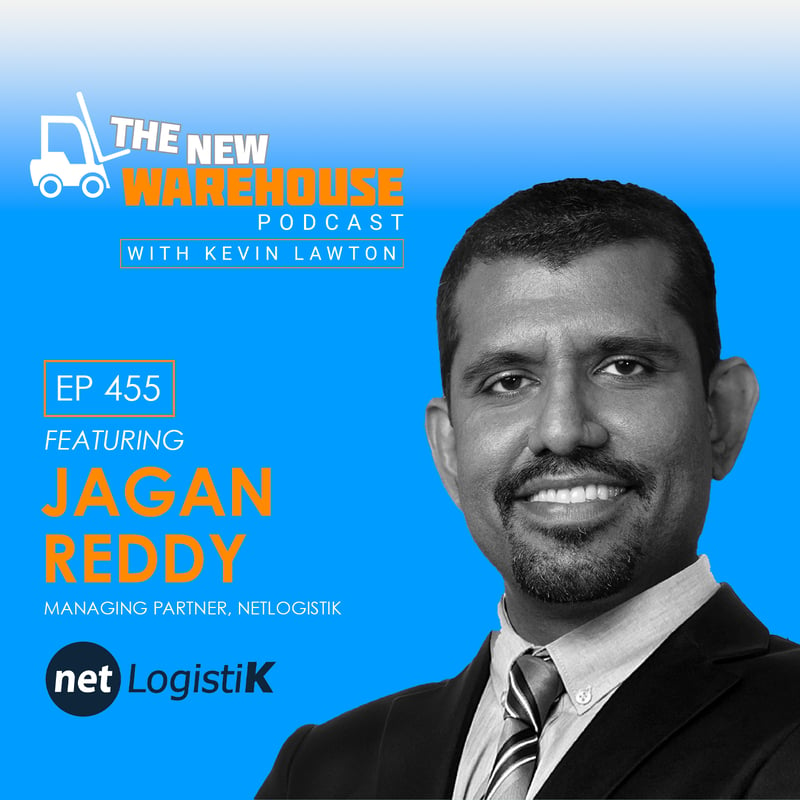
Episode 455: NetLogistik connects the dots for more efficient supply chain operations
237 Sykesville Rd.
Chesterfield, NJ 8515
http://www.thenewwarehouse.com
In this episode of The New Warehouse Podcast, Jagan Reddy, the Managing Partner at NetLogistik US, joins the episode to discuss how NetLogistik is tackling the industry’s current challenges. NetLogistik specializes in creating innovative solutions for Warehouse Management Systems (WMS). Tune in as Kevin and Jagan discuss NetLogistik’s recent Innovation Day and nearshoring, providing valuable insights into the evolving landscape of supply chain technologies and what the future holds in this dynamic field.
Innovation Day: A Forum for Future Supply Chain Trends
Reddy highlighted the company’s commitment to fostering a neutral and objective platform for discussing the future of supply chain management. Unlike typical events run by software companies, NetLogistik’s Innovation Day aims to provide a broad perspective on industry trends and necessary investments.
The event focused on three key areas:
- Understanding near-term supply chain trends
- Innovating at the intersection of traditional software boundaries
- Exploring automation advancements
Reddy elaborates on the changing landscape, noting the overlap of systems like WMS, TMS, and OMS and the increasing need for cohesive solutions. “There’s a lot of need for innovation so that the supply chain can function like a single organism,” he says, underlining the significance of companies like NetLogistik in connecting these dots for more efficient operations.
A significant takeaway from the event was the shift towards mobile automation in warehouses, such as mobile robots for picking and other tasks, offering more flexible and scalable solutions than traditional fixed infrastructure. Reddy also touched on the growing trend of process automation through software bots, transforming routine tasks and streamlining transportation processes. He concludes, “We’re seeing a lot of interest in process automation and mobile goods-to-person systems.”
Leveraging Data Insights for Smarter Warehouse Management
The emerging trend now focuses on enhancing WMS features with additional layers of intelligence. Reddy emphasizes the importance of utilizing the data within a WMS to extract actionable insights. He states, “It’s about how you take the data within a WMS and draw insights from it, then layer it with intelligence so that WMS can sense and adapt to changes in operations.”
This layer of intelligence in WMS enables the system to recommend changes in configurations or processes, adapting to day-to-day variations or long-term shifts within warehouse environments. The integration of such intelligence layers doesn’t necessarily require substantial investments. Reddy describes these as microservices, allowing for cost-effective and swift implementation.
Reddy also discusses the evolving landscape of inventory management, noting the rise of micro fulfillment centers and smaller footprint operations. These newer operations have distinct requirements that differ from larger, national, or regional distribution centers. “There’s a proliferation of micro fulfillment centers… and they need a different footprint of a solution,” says Reddy. These smaller operations require tailored solutions that work hand in hand with the core WMS, sharing data and insights without competing with the primary system.
This approach signifies a shift towards more versatile and responsive WMS solutions capable of catering to the diverse needs of modern warehouse operations.
Navigating the Complexities of WMS Implementation
Reddy explains, “A successful WMS deployment is less about quick implementation and more about getting it done right.” He outlines several vital strategies for successful implementation:
- Prioritize Effective Change Management: Emphasize guiding the organization through the transition rather than rushing the implementation process.
- Establish Clear Objectives: Clearly define the goals of the WMS deployment, whether for technology upgrade, labor efficiency, or inventory accuracy.
- Realistic Planning and Communication: Focus on thoroughly capturing requirements and ensuring clear communication with the implementation team.
- Prepare for the Unexpected: Plan for unforeseen challenges and approach them calmly and collaboratively.
- Support Employee Transition: Provide employees with the necessary support and space to adapt to the new system, recognizing its long-term role in business operations.
Reddy’s approach highlights the importance of a strategic and thoughtful implementation process to ensure the successful integration of a WMS into an organization’s operations.
Key Takeaways
- Trends show a shift towards a unified supply chain ecosystem, emphasizing solutions for the overlap between WMS, TMS, and OMS for seamless operations.
- WMS data intelligence is pivotal for operational adaptability, enabling systems to anticipate changes and optimize processes in real time.
- WMS implementation success hinges on meticulous planning, clear objectives, and robust change management, ensuring a seamless transition and operational efficiency.
The New Warehouse Podcast
EP 455: NetLogistik Connects the Dots for More Efficient Supply Chain Operations









